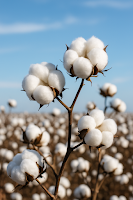Mastering Cotton Cultivation: A Modern Guide for High Yields and Sustainable Profit
Cotton remains one of the world’s leading fiber crops — a key component in everything from clothing to cooking oil. With the right techniques and timing, cotton farming can be both lucrative and sustainable, especially in warm, well-drained regions.
Whether you're new to agriculture or planning to expand into commercial cotton production, this guide will walk you through each stage of the process — from choosing the right variety to harvesting, with smart, updated tips tailored for today’s farming challenges.
What Is Cotton and Why Is It a Valuable Crop?
Cotton is a soft, fibrous crop renowned for its remarkable versatility and wide range of applications.It’s used in the production of textiles, cottonseed oil, paper, and even livestock feed. It’s often dubbed "white gold" because of its economic importance and the consistent income it generates for farmers around the globe.
From its fibers to its seeds, every part of the cotton plant can be used, making it a zero-waste crop in the right hands.
When Should You Plant Cotton?
Timing is everything in cotton cultivation. Here's a general guide based on climate:
| Region Type | Recommended Planting Period |
|---|---|
| Tropical/Hot Zones | March – May |
| Mild/Temperate Zones | April – June |
| Dry/Semi-Arid Areas | February – April |
Environmental Conditions Cotton Thrives In
-
Climate: Warm, dry, and sunny environments are ideal. Daily temperatures between 25°C and 35°C are perfect.
-
Soil: Loamy or sandy-loam soils with good drainage and a pH range of 5.5 to 7.5.
-
Watering: Use drip irrigation to maximize water efficiency and reduce fungal risks.
- Sunlight: Cotton needs a minimum of 6 hours of full, direct sunlight each day to thrive.
Climate: Warm, dry, and sunny environments are ideal. Daily temperatures between 25°C and 35°C are perfect.
Soil: Loamy or sandy-loam soils with good drainage and a pH range of 5.5 to 7.5.
Watering: Use drip irrigation to maximize water efficiency and reduce fungal risks.
Cotton Farming Made Easy: Step-by-Step
1. Select Suitable Varieties
Go for cotton strains that are not only high-yielding but also tailored to your region's weather patterns and pest challenges.
2. Soil Preparation
-
Deep plowing enhances root penetration.
-
Eliminate weeds and old crop residues.
-
Improve soil quality by adding compost or well-aged manure to increase organic matter content.
3. Sowing the Seeds
Deep plowing enhances root penetration.
Eliminate weeds and old crop residues.
Improve soil quality by adding compost or well-aged manure to increase organic matter content.
3. Sowing the Seeds
-
Planting depth: 4–5 cm.
-
Spacing: 25–30 cm between plants and 70–90 cm between rows for healthy growth and airflow.
Planting depth: 4–5 cm.
Spacing: 25–30 cm between plants and 70–90 cm between rows for healthy growth and airflow.
4. Water and Nutrient Management
| Growth Stage | Fertilizer Focus |
|---|---|
| Vegetative | Nitrogen + Phosphorus |
| Flowering | Potassium + Calcium |
| Pre-harvest | Minimal watering, avoid excess moisture |
Use balanced, slow-release fertilizers and adjust feeding based on soil tests for best results.
Cotton Pest and Disease Control
Common threats include:
-
Bollworms
-
Whiteflies
-
Aphids
-
Thrips
Smart Solutions:
-
Introduce beneficial insects like ladybugs.
-
Rotate cotton with legumes or grains.
-
Use pheromone traps and organic pesticides.
-
Apply neem oil or botanical sprays to reduce chemical dependence.
When to Harvest Cotton?
Cotton typically matures within 150–180 days. Harvest indicators include:
-
Naturally opened bolls
-
Browning of leaves and stem drying
-
Appearance of soft, fluffy white fiber
⚠️ Avoid delays in harvest as late picking can result in lower fiber quality due to rainfall or pest damage.
Cotton Farming Economics: Is It Worth It?
Absolutely — when managed efficiently, cotton farming can offer impressive returns.
| Input | Estimated Cost (per acre) |
|---|---|
| Certified Seeds | $60–80 |
| Fertilizer & Irrigation | $110–160 |
| Pest Management | $70–100 |
| Total Cost | $250–320 |
| Potential Profit | $650–1,000+ |
FAQ – Cotton Cultivation Insights
1. Does cotton require a lot of water?
Moderate to high water is needed during the flowering and boll formation stages, but drip systems can drastically reduce total water use.
2. Can I grow cotton in my backyard?
Yes — in warm climates, small-scale cotton can grow in home gardens, though it’s more for learning than profit.
3. Is cotton bad for the environment?
Not inherently. Sustainable practices like organic cotton, reduced chemical use, and efficient irrigation can make cotton eco-friendly.
Final Thoughts
Cotton farming, when approached with modern techniques and sustainable practices, can be an incredibly rewarding venture. By choosing the right variety, optimizing your field conditions, and adopting eco-conscious pest and water management, you can turn a simple cotton plot into a profitable and environmentally sound business.
